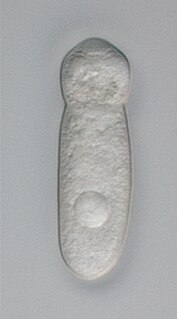Related Research Articles

The Apicomplexa are a large phylum of parasitic alveolates. Most of them possess a unique form of organelle that comprises a type of non-photosynthetic plastid called an apicoplast, and an apical complex structure. The organelle is an adaptation that the apicomplexan applies in penetration of a host cell.

The gregarines are a group of Apicomplexan alveolates, classified as the Gregarinasina or Gregarinia. The large parasites inhabit the intestines of many invertebrates. They are not found in any vertebrates. However, gregarines are closely related to both Toxoplasma and Plasmodium, which cause toxoplasmosis and malaria, respectively. Both protists use protein complexes similar to those that are formed by the gregarines for gliding motility and invading target cells. This makes them excellent models for studying gliding motility with the goal of developing treatment options for toxoplasmosis and malaria. Thousands of different species of gregarines are expected to be found in insects, and 99% of these gregarines still need to be described. Each insect can be the host of multiple species. One of the most studied gregarines is Gregarina garnhami. In general, gregarines are regarded as very successful parasites, as their hosts are spread over the entire planet.

Adeleorina is a suborder of parasites in the phylum Apicomplexa.

Colpodella is a genus of alveolates comprising 5 species, and two further possible species: They share all the synapomorphies of apicomplexans, but are free-living, rather than parasitic. Many members of this genus were previously assigned to a different genus - Spiromonas.
Garnia is a genus of parasitic alveolates belonging to the phylum Apicomplexia.
Aggregata is a genus of parasitic alveolates belonging to the phylum Apicomplexa.
Calyptospora is a genus of parasitic protozoa in the phylum Apicomplexa.
Barrouxia is a genus of parasitic alveolates belonging to the phylum Apicomplexa.
Defretinella is a genus of parasitic alveolates of the phylum Apicomplexa.
Klossiella is a genus of parasitic alveolates of the phylum Apicomplexa. Species in this genus infect the renal tract of mammals and intestinal tract of snakes.
The Archigregarinorida are an order of parasitic alveolates in the phylum Apicomplexa. Species in this order infect marine invertebrates — usually annelids, ascidians, hemichordates and sipunculids.
Cardiosporidium is a genus of parasitic alveolates in the phylum Apicomplexa. It infects the ascidian Ciona intestinalis.
The Neogregarinorida are an order of parasitic alveolates in the phylum Apicomplexa. Species in this order infect insects and are usually found in the fat body, hemolymph, hypodermis, intestine or Malpighian tubules. The most common site of infection is the fat body: many species are pathogenic for their hosts.
Ixorheis is a genus of parasitic alveolates in the phylum Apicomplexa.
Pseudoklossia is a genus in the phylum Apicomplexa. Species in this genus infect marine molluscs, although one species infects in an ascidian worm. The life cycle is heteroxenous.
Selenidioides are a genus of parasitic alveolates in the phylum Apicomplexa. Species in this genus infect marine invertebrates.
The Platyproteum are a genus of parasitic alveolates in the phylum Apicomplexa. Species in this genus infect marine invertebrates.
Meroselenidium is a genus of parasitic alveolates in the phylum Apicomplexa. Species in this genus infect marine invertebrates.
Siedleckia are a genus of parasitic alveolates in the phylum Apicomplexa. Species in this genus infect marine invertebrates.
Aseptatorina is a suborder of parasitic alveolates of the phylum Apicomplexia
References
- ↑ Wakeman KC, Leander BS (2012) Molecular phylogeny of Pacific Archigregarines (Apicomplexa), including descriptions of Veloxidium leptosynaptaen. gen., n. sp., from the sea cucumber Leptosynapta clarki (Echinodermata), and two new species of Selenidium. J Eukaryot Microbiol 59(3):232-45. doi : 10.1111/j.1550-7408.2012.00616.x